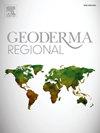苏丹定量土壤制图——系统综述
IF 3.3
2区 农林科学
Q2 SOIL SCIENCE
引用次数: 0
摘要
定量土壤制图(QSM),包括基于scorpan概念的数字土壤制图(DSM)和依赖地质统计学方法(GeoSA)的方法,对于为可持续土壤管理和土地利用规划做出明智决策提供信息非常重要,特别是在发展中国家。这项工作提供了一个系统的回顾QSM文献集中在苏丹2000年和2024年之间。在文献检索中,我们确定了27篇关于苏丹的QSM文章,其中2023年发表的文章数量最多。大多数QSM(16篇文章)使用GeoSA进行预测和映射,而其余的(11篇文章)应用了基于dsm的scorpan概念。普通克里格是最常用的GeoSA,而结合环境协变量(ECOVs:即遥感数据和地形属性)的机器学习算法是近年才出现的。大多数研究针对0-60 cm土壤深度区间,土壤pH和盐/碱度是全国最常见的土壤性质。只有30%的研究在模型评估的同时提供了不确定性估计。苏丹的QSM研究在应用预测模型、利用ECOVs和利用DSM信息方面仍处于早期阶段。在目前的文献中发现了一些挑战和研究空白,应该在未来的研究中进行调查。我们建议建立一个包括苏丹科学家和其他国家感兴趣的科学家在内的国际团队,合作开展研究项目,以改善苏丹的QSM,特别是对DSM的依赖。与此同时,苏丹农业研究公司和联合国粮食及农业组织之间目前的合作可以升级,纳入更先进的技术,以支持国家DSM计划,将QSM的传统目标(即地图制作)转变为业务目标。本文章由计算机程序翻译,如有差异,请以英文原文为准。

Quantitative soil mapping in Sudan−a systematic review
Quantitative soil mapping (QSM), including both digital soil mapping (DSM) based on the scorpan concept and approaches that rely on geostatistical approaches (GeoSA), is important to provide information to make informed decisions for sustainable soil management and land use planning, especially in developing countries. This work provides a systematic review of QSM literature focused on Sudan between 2000 and 2024. In the literature search, we identified 27 QSM articles for Sudan, with the largest number of articles published in 2023. The majority of the QSM (16 articles) utilized a GeoSA for prediction and mapping, while the rest (11 articles) applied the DSM-based scorpan concept. Ordinary kriging was the most used GeoSA, while machine learning algorithms coupled with environmental covariates (ECOVs: i.e., remote sensing data and terrain attributes) only appeared in recent years. Most studies targeted the 0–60 cm soil depth interval, and soil pH and salinity/sodicity were the soil properties most commonly mapped across the country. Only 30 % of studies provided uncertainty estimation along with model assessment. QSM studies in Sudan are still at their early stages in terms of predictive models applied, ECOVs utilized, and utilization of DSM information. Several challenges and research gaps were identified in the current literature that should be investigated in future studies. We recommend the establishment of an international team including Sudanese scientists and interested scientists from other countries to collaborate in research projects that would improve QSM in Sudan, specifically reliance on DSM. Meanwhile, the present collaboration between the Agricultural Research Corporation, Sudan, and the United Nations Food and Agriculture Organization could be upgraded to include more advanced technologies to support a national DSM program that would transform the conventional objective of QSM (i.e., map production) into operational goals.
求助全文
通过发布文献求助,成功后即可免费获取论文全文。
去求助
来源期刊

Geoderma Regional
Agricultural and Biological Sciences-Soil Science
CiteScore
6.10
自引率
7.30%
发文量
122
审稿时长
76 days
期刊介绍:
Global issues require studies and solutions on national and regional levels. Geoderma Regional focuses on studies that increase understanding and advance our scientific knowledge of soils in all regions of the world. The journal embraces every aspect of soil science and welcomes reviews of regional progress.
 求助内容:
求助内容: 应助结果提醒方式:
应助结果提醒方式:


